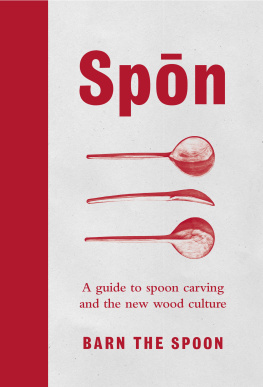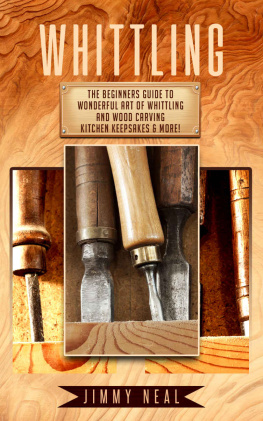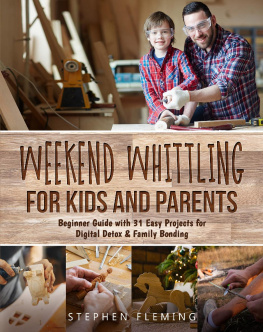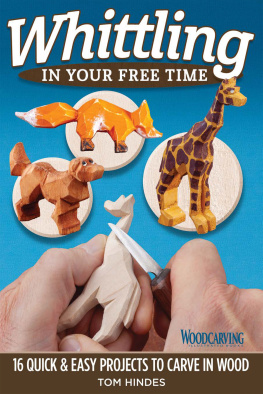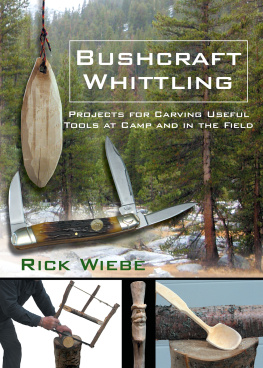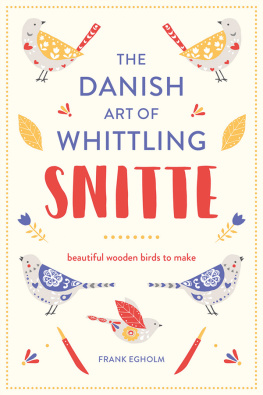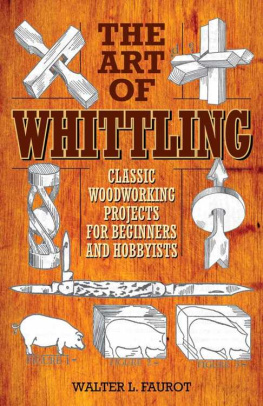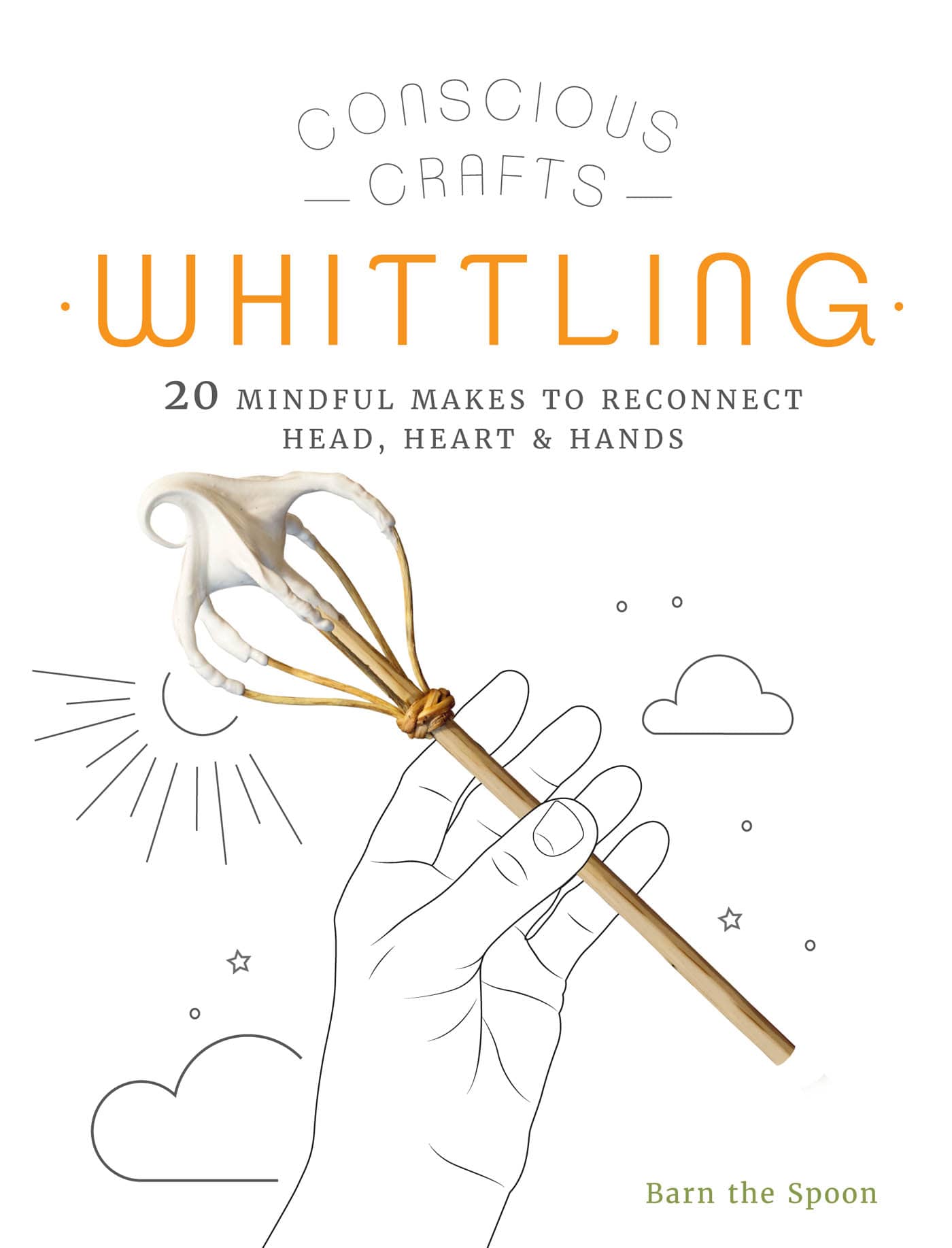Contents
Page List
Guide
Cover
CONSCIOUS CRAFTS WHITTLING
MINDFUL MAKES TO RECONNECT HEAD, HEART & HANDS
Barn the Spoon
contents
introduction
I am a lifelong woodworker, having plied my hands to a variety of crafts including jewellery making, bowl turning and tool making. Spoon carving became my profession in 2009. Beyond becoming my work, carving has been a source of solace and strength, something that has boosted my sense of self, and been a peaceful meditation. I am always drawn back to spoons, and theyve always been there for me when I needed them. Homing in on a form, focusing on the sharp edge, curling shavings away to create the perfect functional sculpture thats what its all about.
I suspect that you will find similar things in this ancient craft; I find people are intuitively drawn towards the act of whittling. Given half a chance, most people will happily take a stick and start pulling shavings as if it were something we were born to do. We are not a blank slate; all evidence points towards that we really did evolve to do these things, which makes sense if you take the time to think it through. The act of shaping wood is as old as we are and crafts of all kinds were once essential for survival.
As modern life has driven us away from what we were born to do, craft has become less of a common activity. But we can make the choice to give ourselves some of what we need, and doing something with our hands is one such thing. In fact, the beauty of whittling is that it encourages other curative activities, too: a new hobby to enjoy by yourself hidden away in your shed, or out in the wilderness, but also a sociable activity that can bring people together. Whittling does not require noisy, dusty, dangerous machines, so there is no need for ear defenders and dust masks, meaning that you can listen and chat. Spoon clubs where people come together to whittle and carve have popped up all over the place, a place where people can meet and form a community.

By its very nature, whittling makes you place value on wood and trees. Far from modern woodwork practices that take you away from the natural material, one of the wonderful things about whittling is how you can source the materials. Many people use wood that has fallen from trees or collect it directly from woodland where a coppice worker has been managing it sustainably. However you source the material, whittling inherently makes you place value on it and where it comes from, making you consider how trees grow, species identification, your local woodland and their management plans.
The fact is that being out in the woods makes most people happy; a gentle summer stroll surrounded by trees and leaves, there is something peaceful about being in these green cathedrals filled with birdsong. Its very grounding being around trees that are hundreds of years old, gentle giants towering above your head, or taking an autumn walk with a Thermos of tea, a chance to sit and just be for a moment. Its a much more natural way to be mindful and present than being taught in a sterile classroom. And our love of trees and wood should come as no surprise these incredible structures that sway in the wind shade us in the summer months, keep us warm with our fires in the winter and even provide the material to build our homes, not to mention plums, apples and cider, and, of course, all the whittling opportunities.
There is hope in the act of making each time you engage with a project. It certainly doesnt always work out even for the seasoned professional; wood as a natural material can provide unexpected challenges, but this is just another opportunity to go back to the drawing board, and what a relief to work on something that in the grand scheme of things is not very important. Hope is certainly something to be nurtured; its what gets us out of bed in the morning! And these projects, in their own little way, inspire that little spark of hope.
Making is important; manifesting something that exists as an idea in our minds into a functioning object is an empowering thing. Many people who spend their time working entirely on screens have found relief in thinking with their hands and engaging senses that had previously been neglected.
In this book you will find accessible projects that can be started and finished in achievable chunks of time, that can be put down and started up again. Working with wood can provide infinite possibilities with few tools required. The journey into making functional, everyday items can be just as rewarding as the meditative act of peeling shavings. I would recommend making the projects many times, as there is a chance for variation and design changes. Trial and improvement are the best friends of a crafter. Finding time to enjoy craft is never selfish; remember that you are, in fact, making a cooking spoon for your aunt. And what a wonderful thought, that you could bring joy into other peoples lives by doing something that is pleasant, and then a precious connection is made too. If you could allow yourself to view self-care as good for the group, then maybe you would do it more often. It is true that when we nurture ourselves, we nurture the group.
My hope is that this craft will inspire you to become increasingly inquisitive about woodlands. Managed woodlands could cover much more of our populated land to increase biodiversity, so many species can happily live side by side with us if we encourage it. Within as little as a lifetime, huge change is possible. Of course, we should do what we can to protect and re-establish wilderness, but closer to home we can perhaps have an even greater impact. This is as much to do with who owns and controls the land use as anything else, supporting those who do great work, holding to account those who dont and most of all enjoying being part of nature.
tools and materials
A very basic kit is all that is necessary to get started on your whittling journey. Heres what I have used for the projects in this book.
1 Classic penknife A typical penknife can be a very useful tool. Its important to note that most of these dont have a locking blade so care must be taken to ensure that it does not close down on to your fingers. A penknife is particularly good for getting into tight concave shapes and lends itself to finishing cuts. I have refined my knife to have a polished, shallow, convex bevel.
2 Folding Stanley knife This short-bladed knife is useful when making cuts with the tip of the blade, because your hand will be closer to the tip and give you more control.
3 Scandinavian-style fixed-blade 'Sljd' knife The sloyd knife derives its name from the Swedish sljd, a handicraft-based educational system. The sljd knife is useful for tasks such as squaring up and smoothing the surface of the wood, because its flat bevels allow greater control when taking planing cuts. In contrast, a typical penknife has a flat grind with a secondary bevel, making it more likely to follow the grain of the wood.


